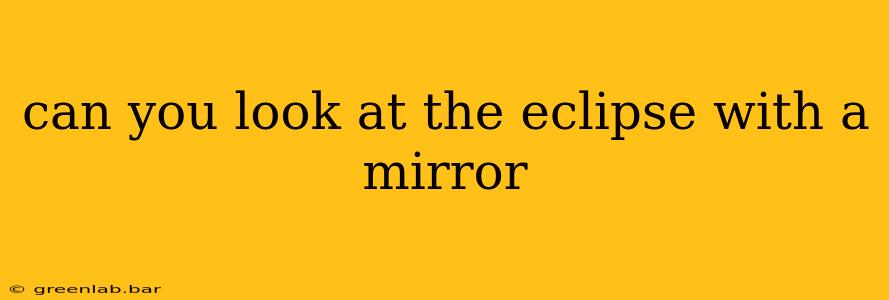The allure of a solar eclipse is undeniable. Witnessing the moon completely or partially obscure the sun is a breathtaking spectacle. However, directly viewing the sun, even during an eclipse, is incredibly dangerous and can cause permanent eye damage, including blindness. So, the question arises: can you safely look at the eclipse using a mirror? The short answer is no, not safely.
The Dangers of Direct Sun Observation
Before we delve into mirror-based viewing, it's crucial to understand why looking at the sun, eclipsed or not, is so risky. The sun emits intense radiation, including ultraviolet (UV) and infrared (IR) light, which can severely damage the retina, the light-sensitive tissue at the back of your eye. This damage can be gradual and imperceptible at first, leading to delayed vision problems that can be irreversible.
Even during a partial eclipse, the sun's rays are still potent enough to cause significant harm. The brightness can trick your eyes into thinking it's safe to look, but the damage is accumulating silently. This is why specialized solar viewers are necessary.
Why Mirrors Don't Offer Safe Viewing
Using a mirror to view the eclipse seems like a clever workaround, but it's fundamentally flawed. Reflecting the sun's rays off a mirror doesn't diminish their intensity. In fact, the focused reflection might even increase the concentration of harmful radiation hitting your eye. This makes mirror-based viewing even more dangerous than looking directly at the sun.
The idea behind using a mirror is often based on a misunderstanding of how light works. While mirrors can be used to observe indirect reflections of less intense light sources, the sun's raw power is simply too much for this method to be safe.
Safe Methods for Eclipse Viewing
Fortunately, several safe and reliable methods exist for observing a solar eclipse:
1. ISO 12312-2 Certified Solar Viewers:
These are inexpensive, readily available, and specifically designed to filter out harmful solar radiation. Look for glasses or viewers explicitly labeled as meeting the ISO 12312-2 standard. Never use homemade filters or regular sunglasses; they don't offer adequate protection.
2. Solar Projection:
This method uses a pinhole camera or a simple projection setup to create a projected image of the sun onto a screen. This indirect observation eliminates the risk of direct exposure to the sun's rays. You can find numerous tutorials online explaining how to build a simple pinhole projector.
3. Telescopes with Solar Filters:
Specialized solar filters are available for telescopes, allowing for safe viewing of the eclipse through a telescope's magnified lens. It is imperative to use only filters specifically designed for solar viewing on telescopes, as any other filter can crack under the intense heat, causing severe eye damage.
Conclusion: Prioritize Eye Safety
Witnessing a solar eclipse is a remarkable experience, but your eyesight should never be compromised. Using a mirror to view a solar eclipse is not a safe option. Always prioritize eye safety by using certified solar viewers or employing safe projection methods. Protecting your vision is paramount – don't let curiosity outweigh caution.

